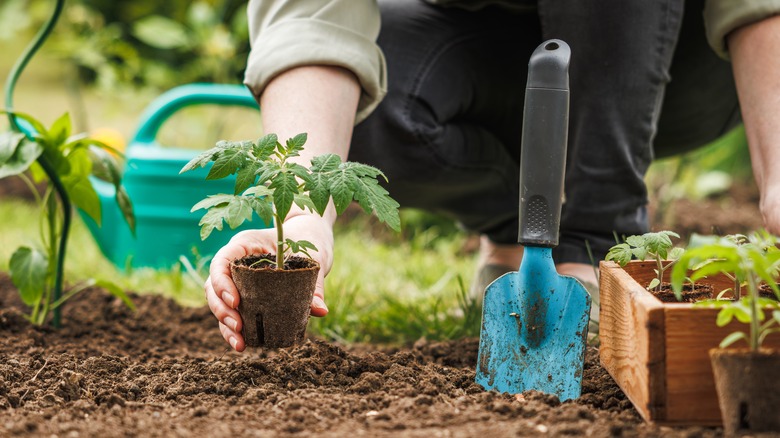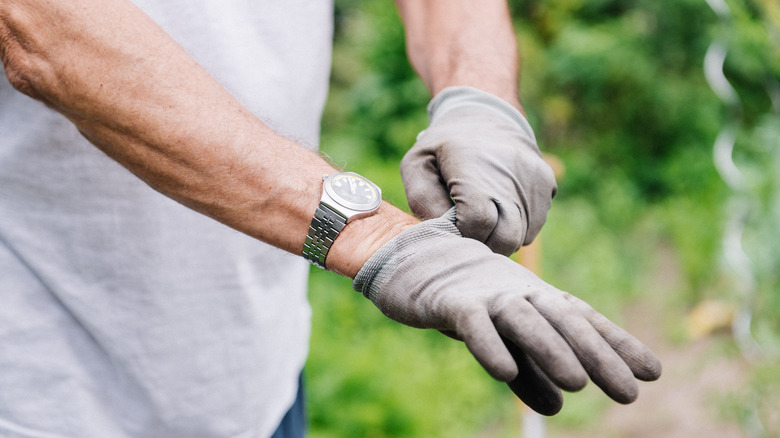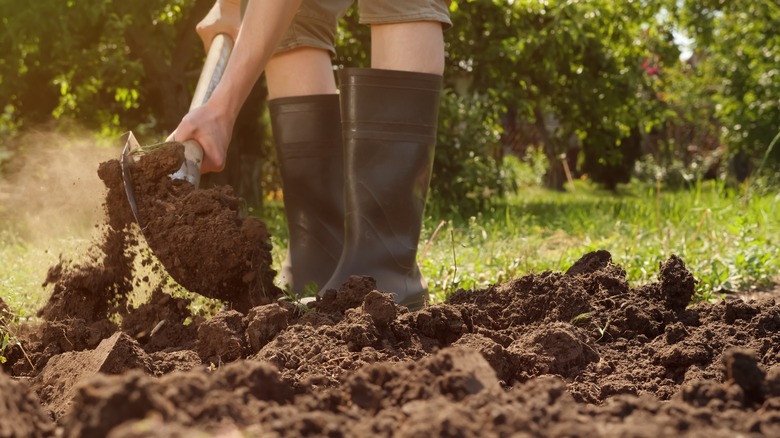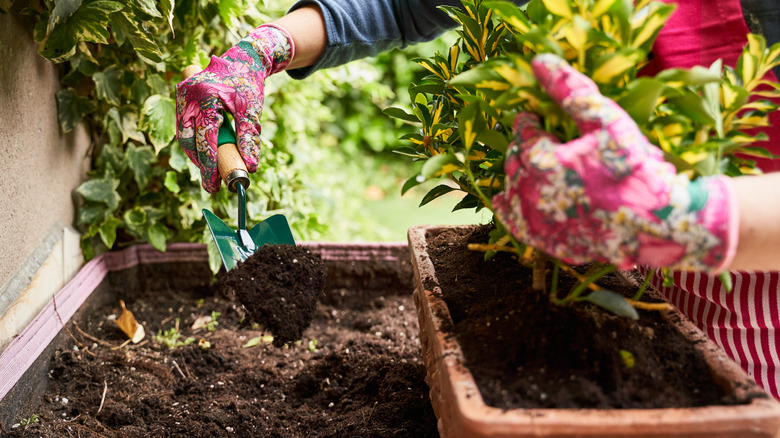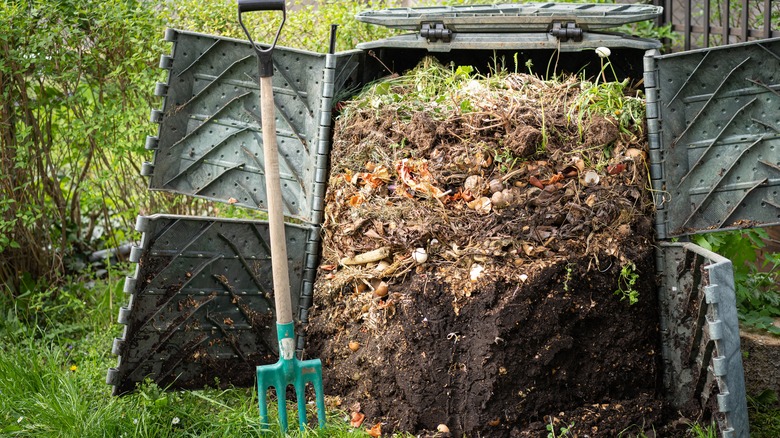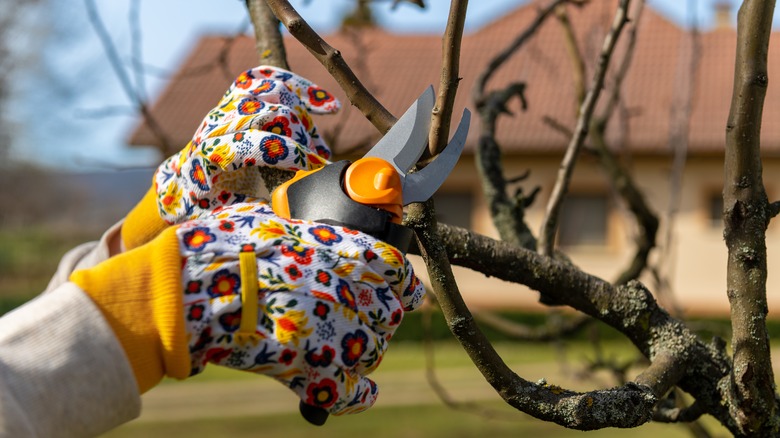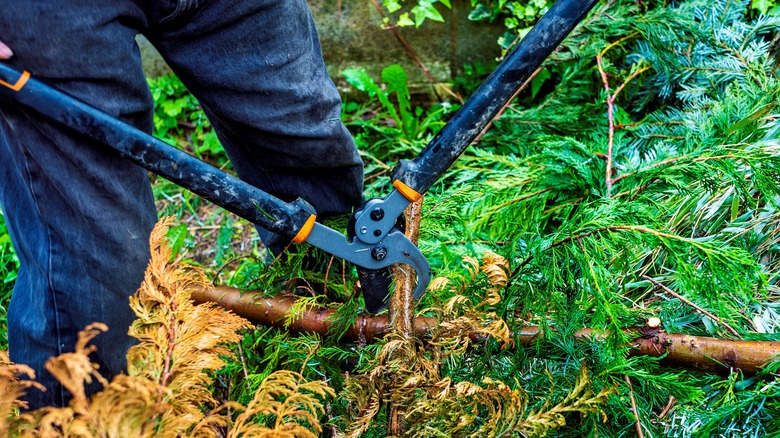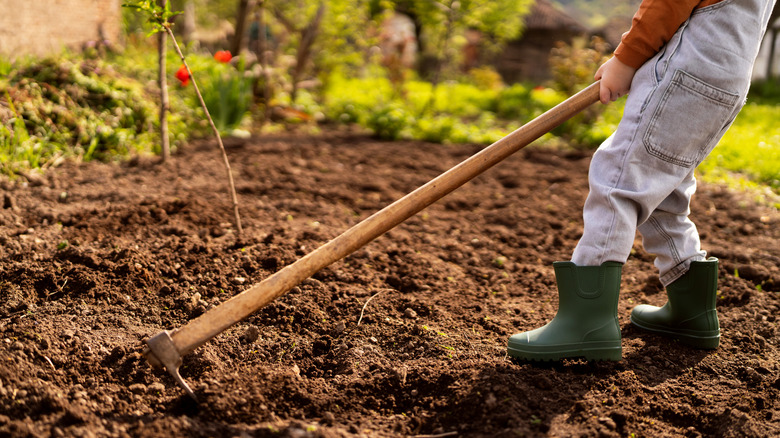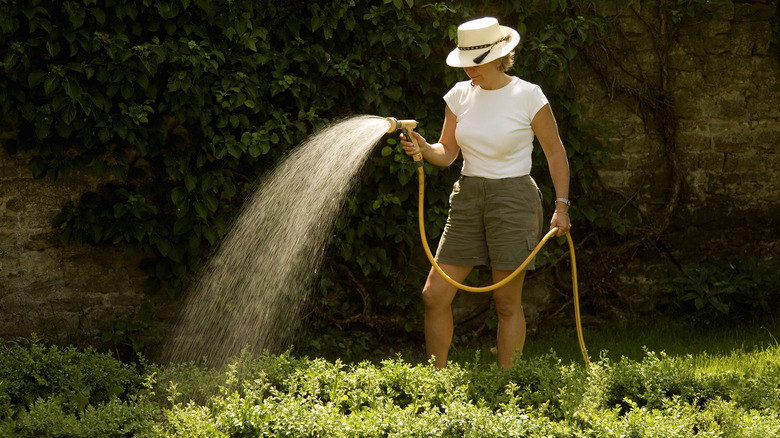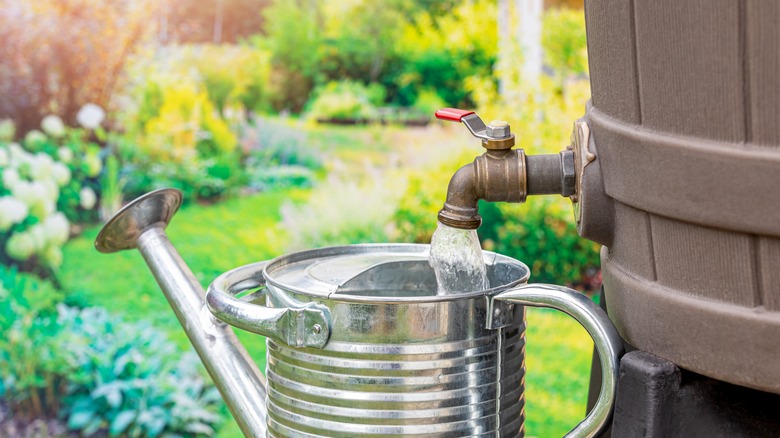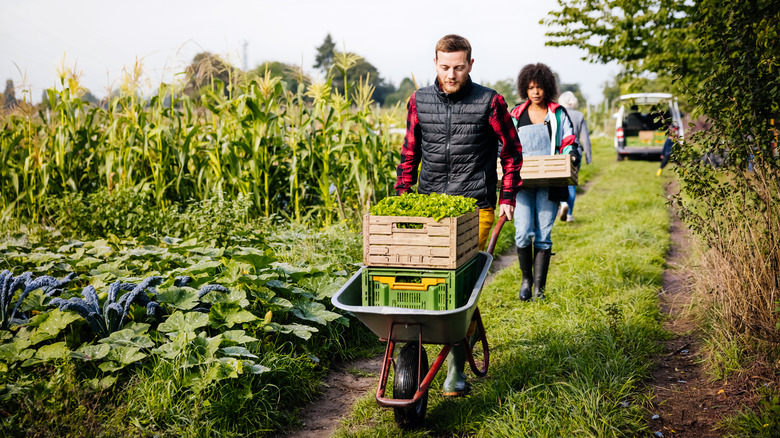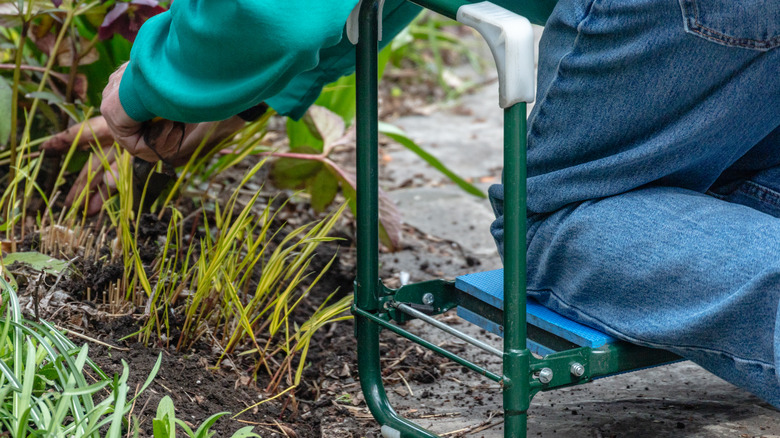Beginning Gardeners, Here Are The Tools You Absolutely Need
There is no question that gardening is trendy. According to Raleigh Realty, 55% of U.S. households have a garden, which is equivalent to roughly 186 million people. With trends, naturally, come newbies. Would-be gardeners who are just getting into growing their first vegetable or flower garden likely don't even know where to begin. Thankfully, we're here to help with that.
While planting tends to be the most intimidating part of first-time gardening, knowing what garden tools to purchase is a challenge in and of itself. There is so much information and so many products out there that it can be very difficult for first-timers to discern what tools to buy and which they don't necessarily need right away.
The natural temptation is to purchase as many tools as possible in the hope that they will all eventually go to use. That would be a rookie gardening mistake, as you'd end up with a shed full of tools you'll never use. Instead, boil your tools down to bare essentials. The following list is a simple gathering of the 12 tools you absolutely need as a first-time gardener.
Protect your hands with sturdy gloves
When it comes to gardening gloves, buy a pair that is tough, sturdy, and will last for years. Spending money on a flimsy pair of gardening gloves is a waste because they'll just end up in the garbage. Instead, spend a little extra and buy some well-made gloves that will last you a lifetime if you take care of them properly. If you do, they will take care of you in turn.
Look for gloves made out of materials like leather, cloth, or neoprene. These materials will stand up to repeated use while also keeping your hands protected. The latter part is incredibly important. Not only will gloves keep your hands clean and blisters to a minimum, but they will also protect your skin from irritants, thorns, and other hazards that could potentially open wounds that could become infected. Sepsis, melioidosis, rose gardener's disease, and legionellosis are all potential conditions that could affect your hands.
Choose gloves for comfort and function. They should fit snugly on your hands, but not so tight as to inhibit movement. Cloth tends to be more breathable than leather, while leather stands up better to long-term abuse. Either way, gardening gloves will keep your hands clean and well-protected.
Dig with ease using long-handled shovels
Whether you're collecting from the compost bin or digging a hole for your new apple tree, having a good long-handled shovel is going to be both ergonomically beneficial, and help you get important gardening tasks done. There are two main types of shovel you want to purchase as a first-time gardener: a standard garden shovel and a spade.
Standard garden shovels are purpose tools that can dig holes and transfer earth or compost. Thanks to their pointed tip and wide, curved edges, garden shovels make quick work of breaking into the earth and doing the grunt work of getting the hole dug. You could buy a wider, square-headed transfer shovel specifically for moving earth, but the pointed shovel is more versatile.
A spade, on the other hand, is a more precise tool. Thanks to its sharp, square edge, spades are excellent at cutting straight edges and not causing too much damage to surrounding vegetation. They come in great handy for creating borders, transplanting turf grass, or digging small irrigation trenches. You could buy one tool over the other, but you're better off buying both for versatility's sake. When you do buy, purchase a shovel and spade with a sturdy, fiberglass handle, and strong blade crimp. These will last a lot longer and stand up to more abuse.
Hand trowels get you close to the earth
The shovel and spade are more generalized tools designed to take on the hard work of getting the garden prepped and ready. When it comes to actual planting, however, there is nothing better than a hand trowel. As they are basically small shovels with shorter handles and long, skinny blades, garden trowels are specifically designed to get you close to the soil in which you're planting.
It can be argued that trowels are the most often used garden tools because they aid in the vital process of planting seeds. Obviously, you won't be using a trowel to dig a hole for a tree. You need a shovel for that job. Instead, trowels excel at digging small holes or creating shallow trenches for seed planting and are great for transferring plants from pot to pot, or pot to ground.
Garden trowels also come in handy when weeding. While there are certain weeds you shouldn't pull, a trowel can get close to the bad weeds, cut their roots, and dig them up without much issue. All told, the trowel is an incredibly versatile tool that every gardener should have from the start. Just make sure you are buying one with a metal blade as they last longer and are easier to clean.
Turn your soil and compost with a garden fork
You could spend several hundred dollars on a motorized rototiller, but you shouldn't. Not for your first garden. Your primary planting is not going to be the massive Eden that you've imagined in your head. That will take several years of hard work to accomplish. Instead, purchase a strong, sturdy garden fork. It's the perfect tool for establishing the smaller space that will be your first garden.
Thanks to its sharp prongs, garden forks are excellent at disturbing the soil and preparing a site for a garden. The most common type, known as a digging fork, is a workhorse at loosening compacted soil and making it loose enough to accept seeds. Digging forks are also excellent at turning over compost, moving leaves, changing soil, and establishing new beds.
Other types of garden forks include a border fork, which is great for softer ground soils and raised beds, and the hand fork, which is basically a hand trowel with tines. These are excellent for getting in between the rows of your plants and pulling any shallow-rooted weeds. Of the three, we'd recommend purchasing the digging fork as it will get the most work done. The jobs of the other two can easily be accomplished by trowels and rakes.
Pruning shears are affordable and multipurpose
Pruning is an important component of gardening. Not only does it allow you to create appealing-looking landscapes, but it also fosters growth in your plants. The best tool for the job is a pair of pruning shears. Whether you're cleaning up your fruit trees or deadheading roses, pruning shears help you get close up to your plants and allow you to find and remove excess growth.
Pruning shears come in varying levels, from basic to heavy duty. As a beginner gardener, you're better off going heavy duty. Look for pruning shears that are made with chrome plating, as they are more durable and corrosion-resistant.
As far as type, bypass pruners are the best to buy. Composed of two curved blades, a bypass pruner can prune with clean cuts and little harm. They are excellent for pruning tree branches, roses, lilacs, and other shrubs. They are also an excellent tool for harvesting produce, especially vine-growing fruits like grapes and tomatoes. Cutting the stem is going to be much easier and cause less damage than pulling the fruit.
Attack thicker branches with loppers
Think of loppers as the grown-up version of pruning shears. With their long handles and thick blades, loppers are at their best when tackling thicker branches. As with hand shears, loppers come in two different varieties: bypass and anvil. Bypass loppers are the most commonly used. Their curved blade creates a clean, precise cut. Anvil loppers are similar, except they have a flat base which, while great at cutting, is less precise and leaves more of a mess.
You can use loppers to get into harder-to-reach places or to cut thicker branches. If you're pruning with them, you want to be steady. Close the loppers around the branch and cut all the way through. The more carefully you do this, the better it will be.
Now, some schools of thought don't recommend using loppers for pruning at all, as they have the potential to twist the cut and cause damage to the plant. However, this is usually because the user has miscalculated and used the tool on wood that is too thick. Still, if you need to clear away some overgrowth or storm debris, loppers are a great tool for removing branches. Anvil loppers are great for this kind of cleanup, so it might be worth investing in both kinds.
Use a metal garden rake to make things tidy
When it comes to the precise and tidying tasks of gardening, beginners cannot go wrong with a bow rake. One of the best tools ever created for the job, these metal rakes are ones that belong in everyone's garden shed. Able to handle a wide variety of different materials, including mulch, gravel, and soil, bow rakes are the primary tool that helps gardeners spread material and keep their garden tidy.
Keep in mind that a bow rake is not the same as a leaf rake. The latter has wide, flexible, multi-tined forks that are great for collecting leaves and moving them into the compost heap. Bow rakes, by contrast, are made of stiff metal tines that excel at turning those raked leaves into the compost and then spreading things out evenly in the garden.
The cool part is that you can use both sides of the bow rake. Use the forked side to break up and move compacted material, and then use the flat side to level everything out. The sturdy tines are also excellent at loosening the tangled sections of your lawn.
The garden hoe has ancient roots
The garden hoe is the only modern gardening tool that has been in use since ancient times. Used by the people of many civilizations — including Mesopotamians and Chinese — as a way to cultivate their gardens, the garden hoe acts as an earth mover. The design is simple: a long handle meeting a curved metal paddle at the bottom. When you need to cultivate soil manually, there is no better tool than a garden hoe.
The most common type of garden hoe is the draw or paddle hoe. This is the one that had the large, square blade on the bottom that is perfect for drawing through dirt and soil, hence its name. Using sweeping motions, garden hoes can be used to dig earth, create new garden rows, move debris out of the way, and remove weeds from the garden beds.
The garden hoe is also excellent at making furrows, which are long, narrow trenches that are excellent for planting seeds. Lettuce, beans, squash, and radishes all benefit from furrow gardening. With a garden hoe, it's as simple as dragging the blade through the soil to make the trench, and then depositing the soil back over the seeds. It's an essential tool that makes gardening a lot easier.
Give your garden a drink with a good hose
If healthy soil is the body of a good garden, water is the blood it needs pumping through its veins to stay alive. You need to be able to get water to your garden. Now, there is a fair amount of work you can do with mulch — when mulch is used correctly — to make sure that the water is retained better in the soil. But the fact remains that you will need to water your garden for it to thrive. For that, you're going to need a hose.
There is no need for a fancy, drip irrigation system unless you're planning on selling your produce for retail or are feeding a large family. A sturdy garden hose is going to be more than sufficient for watering your first garden. Make sure you have one that will reach your garden bed. If your current hose isn't long enough, swap it out for a longer hose and use the old one to make a garden trellis.
As far as hose attachments go, you would do well to buy what's called a hose wand. These are long, curved attachments that can extend your reach, and they include multiple different adjustments for water flow. Most gardens need about one inch of water per week to get by. You can always water more if it's an especially dry season.
Watering cans make for easy watering
While a watering can is not as versatile as a hose, there are still plenty of reasons to have one or two around. If you have smaller, potted plants, or window boxes with flowers in them, a watering can holds the perfect amount of water to feed those plants. They are incredibly mobile, and, depending on the size you get, hold a decent amount of water.
When searching for a watering can, opt for a metal one that will hold at least a gallon of water. Galvanized metal is more durable than plastic and can be left outside to collect rainwater. You can even use watering cans as garden ornaments or pots if you want to bring a bit of whimsy to your yard.
Also, there's a good chance not all of your garden spaces are going to be within distance of your hose. That's okay. It's good exercise to carry watering cans across the yard and over to your smaller flower patches or the hanging baskets on your porch. Plus, a watering can just looks like it belongs in a garden, so if you only buy it because it makes you happy, it's worth buying.
Move soil and produce with a wheelbarrow
We've spent a lot of time on this list telling you about tools like forks, shovels, and rakes that are fantastic at moving material around in your garden or compost pile. But, what about getting that material from Point A to Point B? Answer: a wheelbarrow.
There is no better tool for moving yard materials around than a sturdy wheelbarrow. Go to any hardware store or garden center, and one of the first tools you will see upon entering are wheelbarrows. There are so many different kinds to choose from, but we would opt for the standard wheelbarrow with thick, wooden handles, metal basins, back legs, and a heavy-duty front tire. These are straightforward, simple machines to use for a wide variety of purposes.
Whether you're moving soil, compost, mulch, or filling the basin to the brim with your harvest, your wheelbarrow is going to be your best friend in the garden for many years to come. Thanks to their easy maneuverability, you can move them all around your yard in relative comfort and ease.
Save your back and knees with a kneeler
Gardening requires a lot of time spent on your knees. Whether you're planting seeds, weeding, or mulching your flower beds, you're hunched over and putting nearly all of your body weight on your knees. That can be taxing on your back and other joints. So, for the final must-have tool on this list, buy yourself a kneeler. Your back will thank you for it.
Kneelers can be as simple as a foam pad you carry around with you, or as intricate as a kneeler with tall handles that can be flipped over and turned into a chair. Either way, they both achieve the same purpose. The padded foam displaces your weight, taking a lot of pressure off your knees and back. Using one in the garden may seem a little silly at first, but when you're no longer waking up with aches and pains, you'll be glad you bought one.
If you were to only buy 12 gardening tools, these would be it. They are everything you need to start on your gardening journey. Naturally, your collection will grow the larger and more specialized your garden gets. But, for those just starting out, these are a great collection of simple, affordable tools that will get the job done.
